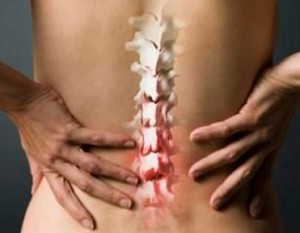Currently, a large number of people suffer from osteochondrosis. Many of them do not even know about the existing problem. Meanwhile, if you do not start treatment on time, complications will occur that will make you feel alone for the rest of your life. Osteochondrosis, like many other diseases, is “getting younger” and significantly worsens the quality of life, taking it out of its normal rhythm.
In our article we will get a little acquainted with the disease itself, and we will focus on the method of treatment of its treatment.
Osteochondrosis and its types
Osteochondrosis is a deformity of the articular cartilage, bone tissue of the spine and intervertebral discs.
Osteochondrosis occurs:

- mesit (lumbosakral),
- cervix,
- chest.
Causes of osteochondrosis:
- standing on foot,
- curvature of the spine,
- spinal cord injury,
- flat feet,
- Frequent rise
- frequent changes in torso position,
- Prolonged stay in uncomfortable position,
- spinal overload,
- physical inactivity and overweight,
- malnutrition,
- stressful conditions.
- Due to certain changes in the intervertebral disc, vertebral instability appears. The spine is very sensitive to injuries.
- The onset of destruction of the fibrous ring of the intervertebral disc occurs. The intervertebral gap narrows. Anulus fibrosus cleaves. The pulposus nucleus of the intervertebral disc protrudes. Due to the formation of an intervertebral hernia, the deformity of the spine is provoked.
- A pronounced pain syndrome occurs. Due to the formation of bone growths and ossification of the spinal ligaments, movements become restricted.
Symptoms of osteochondrosis
lumbar region (lumbosacral)
- Persistent aching pain.
- Feeling of pain and numbness in the limbs.
- Decreased physical activity.
- Increased pain when making sudden movements, lifting weights, exercising, sneezing and coughing.
Cervical region
- Pain in the arms and shoulders, headache.
- Vertebral artery syndrome (burning headache, dizziness, ringing in the head, colored spots and "flies" in front of the eyes).
chest region
- Pain in the internal organs, especially in the chest ("stake" in the chest) and in the heart area.
Determining the diagnosis
The diagnosis is made at a neurologist appointment based on the patient's complaints (pain syndrome, limited mobility, etc. ). The spine is examined by him in the position of the patient standing, sitting and lying down (at rest and in motion). During the examination of the back, attention is paid to the posture, structural features of the trunk, lower corners of the shoulders, lateral contours of the neck and waist, the position of the shoulder straps, etc. After that, the doctor, as a rule, directs the patient for x-rays, computed tomography or MRI, with the help of which the diagnosis is clarified and concretized, the degree of damage is determined and hidden deviations from the norm are detected. Based on the data obtained, the neurologist prescribes the appropriate treatment. As a rule, this is a complex therapy, which includes the use of medication, massage, exercise therapy and other methods.
Therapeutic exercises for osteochondrosis of the lumbar spine

Treatment of osteochondrosis with medication
To begin with, it should be noted that in the early stages of osteochondrosis development, in some cases, you can do without medication. It will be enough to use medical gymnastics, all kinds of applicants, as well as to reduce the load and eliminate other causes of the disease. If symptoms are getting worse, and studies have shown characteristic changes, medications that help influence both the cause and the symptoms of osteochondrosis should be used.
Treatment of osteochondrosis with medication is indicated during the period of its exacerbation and aims to alleviate the inflammatory process, relieve pain and increase metabolic processes due to internal intake or administration of drugs using injections.
Due to the fact that osteochondrosis is a systemic disease that adversely affects various organs and systems, its treatment should be comprehensive. Medications for the treatment of osteochondrosis perform the following tasks:
- pain relief,
- removal of inflammation,
- improve blood circulation to affected tissues,
- cartilage restoration,
- restoring mobility in joints,
- elimination of depression caused by persistent pain.
So what medications can be prescribed by a neurologist to treat osteochondrosis?
- NSAID (non-steroidal anti-inflammatory drug).
Eliminate inflammation and pain. They are used externally (gels, creams), internally (capsules, tablets), as well as in the form of injections (intramuscular, intravenous, subcutaneous).
- Vasodilators (vasodilators).
As a result of muscle tension and pain in osteochondrosis, narrowing of blood vessels occurs. In order to avoid undesirable consequences in the background of this, the doctor may prescribe vasodilator medications for a better restorative effect.
- Muscle relaxants (muscle relaxants).
Muscle relaxants have a relaxing and calming effect on muscles. The process of healing without drugs of this group continues more slowly, as due to their properties, blood circulation is normalized, pain sensations are dulled, mobility is restored and the affected tissues heal faster.
- Chondroprotectors.
Chondroprotectors do not cause further destruction, they stabilize the condition. Taking chondroprotectors is long-term, lifelong, the effect occurs after treatment for a period of at least 6 months. Chondroprotectors are used externally, internally and in the form of injections.
- glucosamine
- kondroitin
- glucosamine + chondroitin
- glucosamine + chondroitin + vitamins
- Sedatives (sedatives).
Long-term pain syndrome can cause stress and depression. In this case, herbal preparations of valerian, mother, bark are prescribed. For more severe disorders, antidepressants are used and hypnotics are used to improve the process of falling asleep and the quality of sleep.
- Vitamins and vitamin-mineral complexes.
B vitamins are of great importance here, as they are able to restore the sensitivity of the affected nerve fibers and reduce pain.
In order to strengthen the overall body, vitamin and mineral complexes can also be prescribed.

























